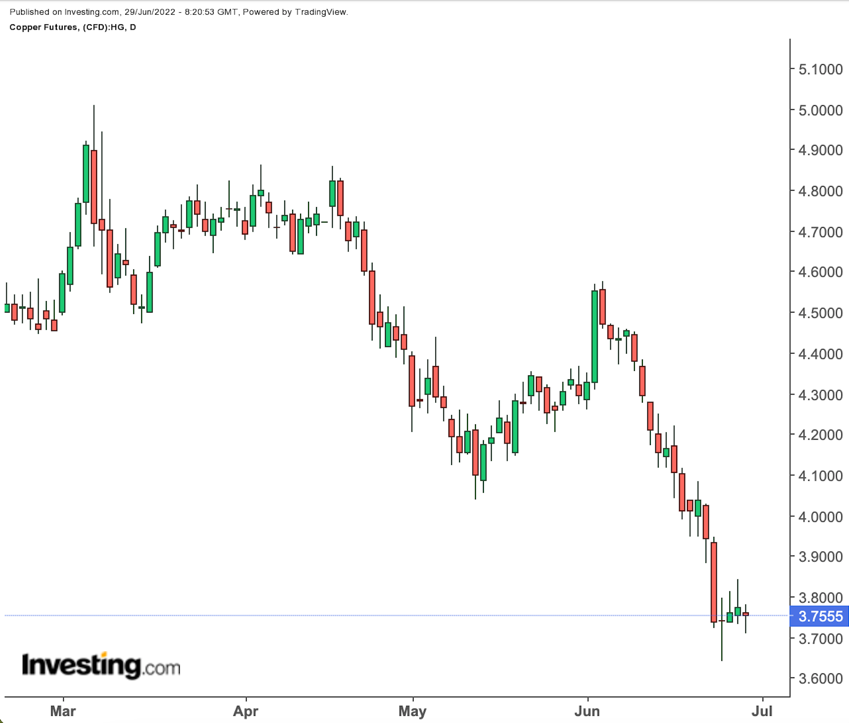Almost a week after its worst crash in 20 months, copper appears on the verge of a comeback. But fears that the United States—and maybe even the world—will enter a recession due to unmanageable inflation is thwarting copper’s recovery both fundamentally and technically.
In fact, charts suggest that another 9% drop may be needed for it to reach levels truly supportive of a strong rebound.
Used broadly in the power, telecom, and construction sectors, the red metal’s legend as a gauge of the global economy is so great that it’s even called “Dr. Copper”. It is often said that an astute analyst would be able to predict the turning points in economic cycles and grasp the overall health of the world economy simply by just studying copper’s prices and charts.
That copper is front-running the global commodity market reaction to recessionary concerns should, therefore, not be surprising. And that really is the problem for longs hoping to recapture copper’s record highs of above $5 per lb, which came two weeks after the Russian invasion of Ukraine on Feb. 24 that led to the West’s sanctions on Moscow and the upheaval of the global economy.
US copper’s benchmark front-month hovered at under $3.74 per lb ahead of Wednesday’s open on New York’s COMEX. That was a notch higher than its June 23 low of $3.72, which came on the back of a 5.2% crash in COMEX copper, the worst since Oct. 1, 2020.
From its record high of $5.01 on Mar. 7, copper has lost 25%, putting it well within the bear-market classification given for any asset down 20% or more from its most recent peak.
"We expect base metals to extend losses following their recent fall caused principally by the Fed's tightening and China's economic slowdown on the back of the country's zero-COVID policy," Fitch Solutions said in a note after last week’s 5% crash in COMEX copper. A stronger dollar and weaker global economic growth will cause “a significant drop in demand across base metals,” Fitch predicted, adding that “risks are broadly skewed to the downside".
Fundamentally, Copper Shrouded By Recession Fears
Fundamentally, there are good reasons to be pessimistic about copper now.
Manufacturing growth is slowing from Asia to Europe as China's COVID-19 curbs from earlier in the year and the Russia-Ukraine conflict disrupt supply chains.
In the United States at least, economists fear that the most aggressive rate hikes in a generation by the Federal Reserve and the central bank’s soon-to-follow quantitative tightening—where hundreds of billions of dollars of bonds in its holdings will be sold—will push the economy into a recession.
The Federal Reserve imposed this month a 75-basis point rate hike that was the highest in 28 years. The economy contracted by 1.4% in the first quarter of the year and will technically slip into a recession if it does not return to positive growth by the end of the second quarter.
St. Louis Fed President Jim Bullard, arguably the central bank’s biggest policy hawk, said on Tuesday that policy-makers needed to stay ahead of inflation by front-loading interest rates. His colleague, San Francisco Fed Chief Mary Daly concurred, saying:
"I am myself worried that left unbridled, inflation would be a major constraint and threat to the US economy and continued expansion."
The Fed hopes to get inflation ramping at 40-year highs of 8% and above to pre-COVID levels of 2% and below. What’s getting busted instead is consumer confidence, which fell for a second straight month in June and to its lowest since February 2021 as fuel and food prices took a greater toll on Americans’ optimism about the economy, data on Tuesday from The Conference Board said.
Adding to the weight on copper prices, union leaders at Chile's state-owned mining firm Codelco, the world's largest copper producer, reached an agreement with their management last week to end a national strike over the decision to close a smelter located in a highly polluted area.
Technically, Copper May Need to Drop Another 9%
Technically, copper is on brittle ground too.
While the sell-off in COMEX futures have stopped since the June 23 low of $3.72, prices have risen no more than 2 cents from that trough, suggesting that a deeper decline is in the offing, possibly one that could take it to the next support point of $3.64.
From there, the dive could hasten toward the 50-month Exponential Moving Average of $3.59 and the 200-week Simple Moving Average of $3.40.
A drop to $3.40 means copper would have to lose about 9% more from current levels.
If indeed copper gets that far down, then a stronger rebound may be on the cards.
Stochastic readings of 14/15 on the daily charts of COMEX’s front-month copper and 8/6 on the weekly chart have started indicating some oversold conditions.
At $3.40 and under, these could trigger a rebound from the lows where buyers may start joining the reactive upward swing as copper approaches value zones with the 100-week Simple Moving Average of $4.05 and the daily middle Bollinger Band of $4.12. A further strengthening of the trend could call into action the 50-Day Exponential Moving Average of $4.21.
Here are key technical levels to watch:
$3.64 - $3.40 – Short term range for downside.
$4.03 - $4.10 – Horizontal resistance zone, though this can easily yield to upward momentum.
$4.05 - $4.20 – Stronger upside resistance levels.
Disclaimer: Barani Krishnan uses a range of views outside his own to bring diversity to his analysis of any market. For neutrality, he sometimes presents contrarian views and market variables. He does not hold a position in the commodities and securities he writes about.
